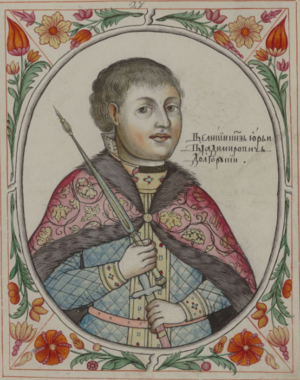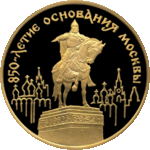يوري دولگوروكي
| Yuri Dolgorukiy | |||||
|---|---|---|---|---|---|
 | |||||
| Prince of Rostov and Suzdal | |||||
| العهد | ح. 1108[1] or 1125[2] – 1157[2] | ||||
| سبقه | First [1] | ||||
| تبعه | Andrey Bogolyubsky[3] | ||||
| Grand Prince of Kiev (first) | |||||
| العهد | 1149–1151 | ||||
| سبقه | Iziaslav II Mstislavich | ||||
| تبعه | Iziaslav II Mstislavich | ||||
| Grand Prince of Kiev (second) | |||||
| العهد | 1155–1157 | ||||
| سبقه | Iziaslav III Davidovich | ||||
| تبعه | Iziaslav III Davidovich | ||||
| وُلِد | 1099 | ||||
| توفي | 15 May 1157 (aged 57) | ||||
| الدفن | |||||
| الزوج |
| ||||
| الأنجال | |||||
| |||||
| الأسرة |
| ||||
| الأب | Vladimir II Monomakh | ||||
Yuri I Vladimirovich (روسية: Юрий Владимирович, romanized: Yury Vladimirovich; قالب:Lang-orv; c. 1099 – 15 May 1157), commonly known as Yuri Dolgorukiy (روسية: Юрий Долгорукий, النطق Yury Dolgoruky, حرفياً 'Long-armed') or the Long Arm, was a Monomakhovichi prince of Rostov and Suzdal, acquiring the name Suzdalia during his reign.[2] Noted for successfully curbing the privileges of the landowning boyar class in Rostov-Suzdal and his ambitious building programme, Yuri transformed this principality into the independent power that would evolve into early modern Muscovy.[4] Yuri Dolgorukiy was the progenitor of the Yurievichi[5] (روسية: Юрьевичи, romanized: Yuryevichi أوكرانية: Юрійовичі, romanized: Yuriiovychi), a branch of the Monomakhovichi.
Yuri spent much of his life in internecine strife with the other Rus' princes for suzerainty over the Kievan Rus, which had been held by his father (Vladimir Monomakh) and his elder brother before him.[بحاجة لمصدر] Although he twice managed to briefly hold Kiev (in September 1149 – April 1151, again in March 1155 – May 1157) and rule as Grand Prince of Kiev, his autocratic rule and perceived foreigner status made him unpopular with the powerful Kievan boyars, leading to his presumed poisoning and the expulsion of his son (later Andrei Bogoliubsky of Vladimir-Suzdal) in 1157.[بحاجة لمصدر] His rule marked the effective end of the Rus' as a unified entity until the Mongol invasions, with powerful provincial territories like Vladimir-Suzdal and Galicia-Volhynia now competing for the throne of Kiev.[بحاجة لمصدر]
. . . . . . . . . . . . . . . . . . . . . . . . . . . . . . . . . . . . . . . . . . . . . . . . . . . . . . . . . . . . . . . . . . . . . . . . . . . . . . . . . . . . . . . . . . . . . . . . . . . . . . . . . . . . . . . . . . . . . . . . . . . . . . . . . . . . . . . . . . . . . . . . . . . . . . . . . . . . . . . . . . . . . . . .
Biography
Birth
قالب:Original research section Yuri was the sixth son of Vladimir Monomakh. It is unclear when Yuri was born. Some chronicles report that Yuri's elder brother, Viacheslav, said to him: "I am much older than you; I was already bearded when you were born."[بحاجة لمصدر] Since Viacheslav was born in 1083, this supposedly pushes Yuri's birth to c. 1099/1100.[بحاجة لمصدر] However, the Primary Chronicle records the first marriage of Yuri – on 12 January 1108. It means that Yuri was born before c. 1099/1100 (as he could not have been 6–9 years old at the time of marriage).[بحاجة لمصدر]
Activities in Rostov and Suzdal
In 1108 Vladimir Monomakh sent his young son Yuri to govern in his name the vast Vladimir-Suzdal principality in the north-east of Kievan Rus'. In 1121 Yuri quarreled with the boyars of Rostov and moved the capital of his lands from that city to Suzdal. As the area was sparsely populated, Yuri founded many fortresses there. He established the towns of Ksniatin (in 1134), Pereslavl-Zalesski and Yuriev-Polski (in 1152), and Dmitrov (in 1154). The establishment of Tver, Kostroma, and Vologda is also popularly assigned to Yuri.[بحاجة لمصدر]
In 1147 Yuri Dolgorukiy had a meeting with Sviatoslav Olgovich (then prince of Belgorod Kievsky) in a place called Moscow. In 1156 Yuri fortified Moscow with wooden walls and a moat.[بحاجة لمصدر] Although the settlement probably existed later or earlier, Dolgorukiy is often called "the Founder of Moscow".[بحاجة لمصدر]
Struggle for Kiev
For all the interest he took in fortifying his Northern lands, Yuri still coveted the throne of Kiev. It is his active participation in the Southern affairs that earned him the epithet of Dolgorukiy, "the far-reaching". His elder brother Mstislav of Kiev died in 1132, and "the Rus lands fell apart", as one chronicle put it. Yuri instantaneously declared war on the princes of Chernigov, the reigning Grand Prince and his brother Yaropolk II of Kiev, enthroned his son in Novgorod, and captured his father's hereditary principality at Pereyaslav of the South. The Novgorodians, however, betrayed him, and Yuri avenged by seizing their key eastern fortress, Torzhok.[بحاجة لمصدر]
In 1147, Dolgorukiy resumed his struggle for Kiev and in 1149[بحاجة لمصدر] he captured it, but in 1151 he was driven from the capital of Rus by his nephew Iziaslav. In 1155, Yuri regained Kiev once again. After presumably being poisoned at the feast of a Kievan nobleman, Yuri unexpectedly died in 1157 which sparked anti-Suzdalian uprising in Kiev.[بحاجة لمصدر] Yuri Dolgoruki was interred at the Saviour Church in Berestovo, Kiev, but his tomb is empty.[بحاجة لمصدر]
Marriages and children
The Primary Chronicle records the first marriage of Yuri on 12 January 1108. His first wife was a daughter of Ayyub Khan (in Slavic sources: Аепа Осенев, Aepa son of ru (Osen(khan))),[6] Khan of the Cumans. Her paternal grandfather was Osen. Her people belonged to the Cumans, a confederation of pastoralists and warriors of Turkic origin.[بحاجة لمصدر]
His second wife Helena survived him and moved to Constantinople. Her paternity is not known for certain, but Nikolay Karamzin was the first to theorise that Helena was returning to her native city. She has since been theorised to be a member of the Komnenos dynasty which ruled the Byzantine Empire throughout the life of Yuri.[بحاجة لمصدر]
Yuri had at least fifteen children.[بحاجة لمصدر] The identities of the mothers are not known for certain.[بحاجة لمصدر]
- The following are considered elder children and usually attributed to the first wife.
- Rostislav, Prince of Pereyaslavl (d. 6 April 1151).
- Ivan, Prince of Kursk (d. 24 February 1147).
- Olga (d. 1189). Married Yaroslav Osmomysl.
- Andrei I Bogolyubsky (c. 1111 – 28 June 1174).
- Maria. Married Oleg Sviatoslavich, Prince of Novhorod-Siverskyi.
- Sviatoslav (d. 11 January 1174).
- Yaroslav (d. 12 April 1166).
- Gleb of Kiev (d. 1171).
- Boris, Prince of Belgorod and Turov (d. 12 May 1159).
- Mstislav, Prince of Novgorod (d. 1166).
- Vasilko, Prince of Suzdal (deposed in 1161).
- The following are considered youngest and typically attributed to the second wife
- Mikhail of Vladimir (d. 20 June 1176).
- Vsevolod the Big Nest (1154 – 12 April 1212).
- Yaropolk.
نصب تذكارية
Yuri's memory is cherished as the legendary founder of Moscow. His patron saint, Saint George appears on the coat of arms of Moscow slaying a dragon. In 1954, a monument to him designed by sculptor Sergei Orlov was erected on Moscow's Tverskaya Street, the city's principal avenue, in front of the Moscow municipality.[بحاجة لمصدر]
Dolgoruki's image was stamped on the Medal "In Commemoration of the 800th Anniversary of Moscow", introduced in 1947.[بحاجة لمصدر]
There are monuments of Yuri Dolgorukiy in Dmitrov and Kostroma.[بحاجة لمصدر]
The nuclear submarine RFS Yury Dolgoruky is named after him.[بحاجة لمصدر]
معرض صور
- Dolg dmit.JPG
Monument to Yuri Dolgoruky in Dmitrov
- Dolg kost.JPG
Monument to Yuri Dolgoruky in Kostroma
الهامش
- ^ أ ب Martin 2007, p. 43.
- ^ أ ب ت Martin 2007, p. 110.
- ^ Martin 2007, p. 92.
- ^ Presniakov, Alexander E. (1986) [1918]. The Tsardom of Muscovy. Translated by Price, Robert F. Petrograd: Academic International Press. pp. ix–x. ISBN 9780875690902.
- ^ Martin 2007, pp. 122–124, 127–128, 130, 133, 145, 491.
- ^ The Russian Primary Chronicle, Laurentian Text (PDF). Translated by Hazzard Cross, Samuel; Sherbowitz-Wetzor, Olgerd P. Cambridge, Massachusetts: The Mediaeval Academy of America. 1953. p. 204. LCCN 53-10264.
Yuri Dolgorukiy Yurievichi وُلِد: 1099 توفي: 15 May 1157
| ||
| ألقاب ملكية | ||
|---|---|---|
| سبقه ? |
Prince of Rostov and Suzdal 1108–1157 |
تبعه Andrei Bogolyubsky |
| سبقه Iziaslav II |
Grand Prince of Kiev 1149–1151 |
تبعه Iziaslav II Viacheslav I |
| سبقه Rostislav I |
Grand Prince of Kiev 1155–1157 |
تبعه Iziaslav III |
References
. . . . . . . . . . . . . . . . . . . . . . . . . . . . . . . . . . . . . . . . . . . . . . . . . . . . . . . . . . . . . . . . . . . . . . . . . . . . . . . . . . . . . . . . . . . . . . . . . . . . . . . . . . . . . . . . . . . . . . . . . . . . . . . . . . . . . . . . . . . . . . . . . . . . . . . . . . . . . . . . . . . . . . . .
Bibliography
- Martin, Janet (2007). Medieval Russia: 980–1584. Second Edition. E-book. Cambridge: Cambridge University Press. ISBN 978-0-511-36800-4.
- Articles with hatnote templates targeting a nonexistent page
- Missing redirects
- Articles containing روسية-language text
- Pages using Lang-xx templates
- Articles containing أوكرانية-language text
- Articles with unsourced statements from March 2024
- Articles with unsourced statements from May 2023
- Articles with unsourced statements from December 2020
- Yurievichi family
- Monomakhovichi family
- Grand princes of Kiev
- History of Moscow
- 1099 births
- 1157 deaths
- 12th-century monarchs in Europe
- Burials at the Church of the Saviour at Berestove





